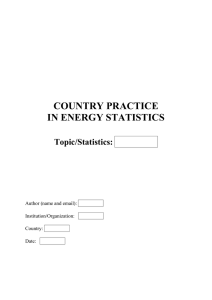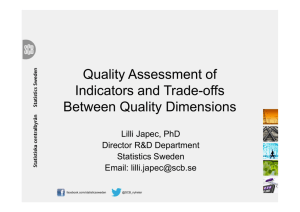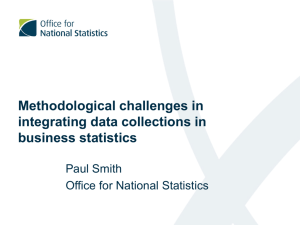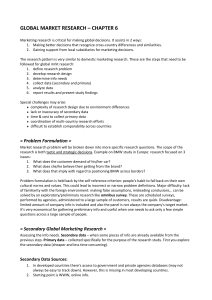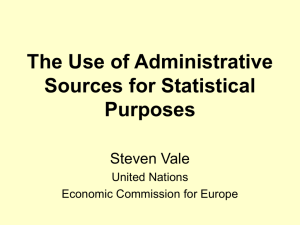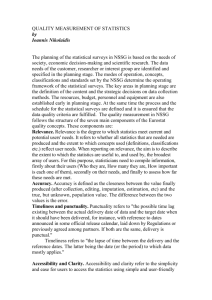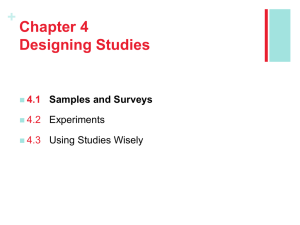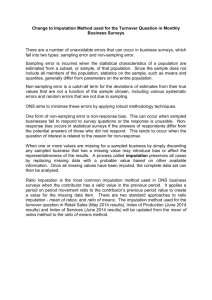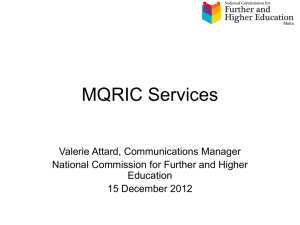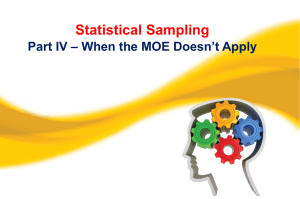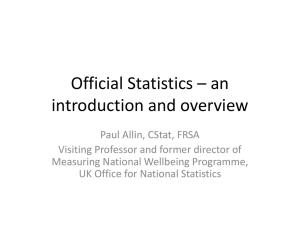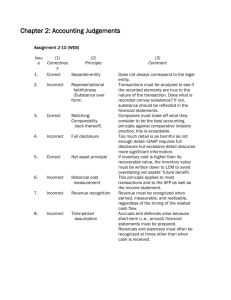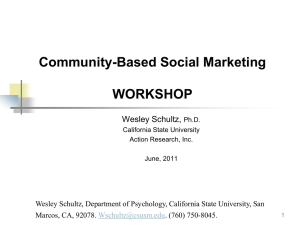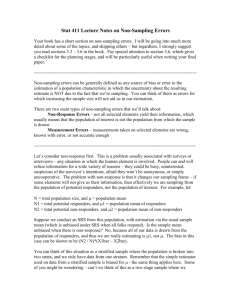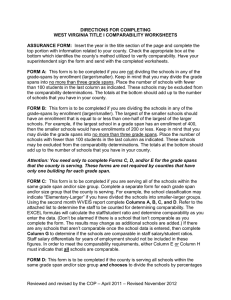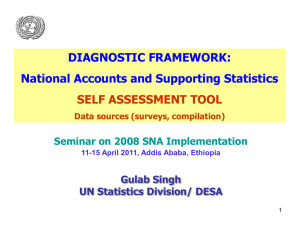Guidelines for Publishing Data Subject to Error
advertisement
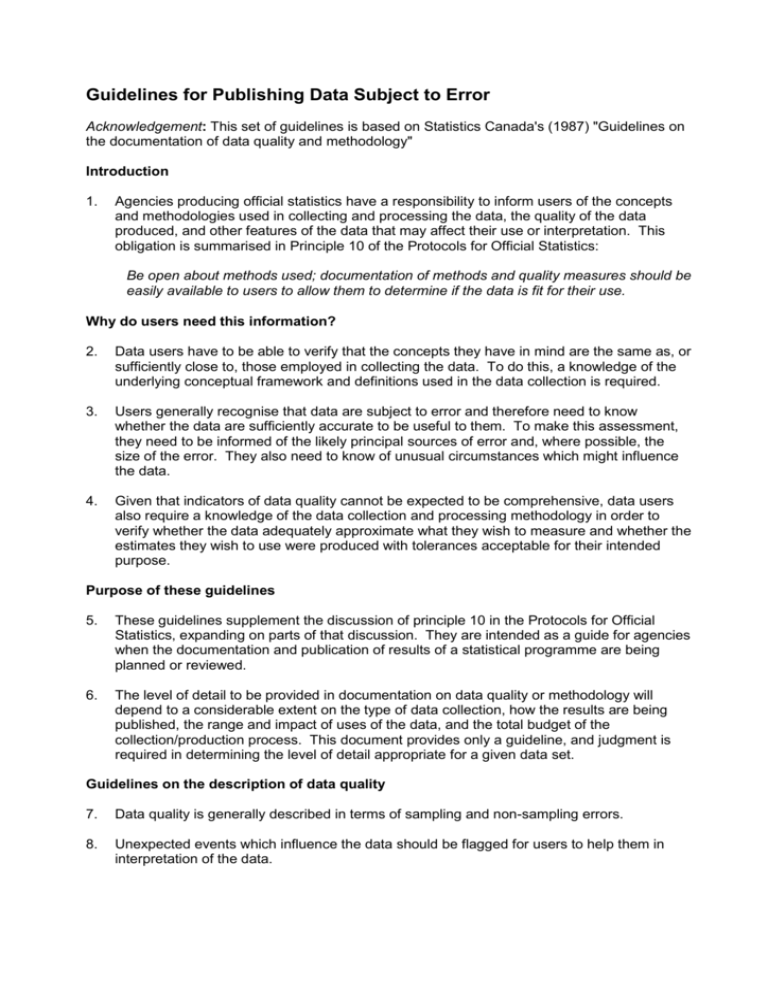
Guidelines for Publishing Data Subject to Error Acknowledgement: This set of guidelines is based on Statistics Canada's (1987) "Guidelines on the documentation of data quality and methodology" Introduction 1. Agencies producing official statistics have a responsibility to inform users of the concepts and methodologies used in collecting and processing the data, the quality of the data produced, and other features of the data that may affect their use or interpretation. This obligation is summarised in Principle 10 of the Protocols for Official Statistics: Be open about methods used; documentation of methods and quality measures should be easily available to users to allow them to determine if the data is fit for their use. Why do users need this information? 2. Data users have to be able to verify that the concepts they have in mind are the same as, or sufficiently close to, those employed in collecting the data. To do this, a knowledge of the underlying conceptual framework and definitions used in the data collection is required. 3. Users generally recognise that data are subject to error and therefore need to know whether the data are sufficiently accurate to be useful to them. To make this assessment, they need to be informed of the likely principal sources of error and, where possible, the size of the error. They also need to know of unusual circumstances which might influence the data. 4. Given that indicators of data quality cannot be expected to be comprehensive, data users also require a knowledge of the data collection and processing methodology in order to verify whether the data adequately approximate what they wish to measure and whether the estimates they wish to use were produced with tolerances acceptable for their intended purpose. Purpose of these guidelines 5. These guidelines supplement the discussion of principle 10 in the Protocols for Official Statistics, expanding on parts of that discussion. They are intended as a guide for agencies when the documentation and publication of results of a statistical programme are being planned or reviewed. 6. The level of detail to be provided in documentation on data quality or methodology will depend to a considerable extent on the type of data collection, how the results are being published, the range and impact of uses of the data, and the total budget of the collection/production process. This document provides only a guideline, and judgment is required in determining the level of detail appropriate for a given data set. Guidelines on the description of data quality 7. Data quality is generally described in terms of sampling and non-sampling errors. 8. Unexpected events which influence the data should be flagged for users to help them in interpretation of the data. 9. It is not generally possible to provide comprehensive measures of data quality. Rather one should aim to identify what are thought to be the most important sources of error and provide quantitative measures where possible or qualitative descriptions otherwise. The result should be a balanced discussion which addresses itself to specific sources of error or bias and is therefore informative to users. 10. For censuses, surveys or administrative data surveys, the description should cover as many as possible of the elements described in paragraph 12 below. 11. Statistics derived from administrative data can also be dealt with under the guidelines of paragraph 12, but it is likely that the information available will be less detailed. Nevertheless, important issues such as coverage, response errors and comparability over time should be discussed. Data quality descriptions 12. The following aspects of data quality are regarded as basic and, subject to constraints of cost and feasibility, some indication of their level should be provided or made available, where applicable, for every statistical product: a. Coverage: the quality of the survey frame or list (for surveys or censuses) or source files (for administrative data) as a proxy for the desired universe should be addressed (including gaps, duplications and definitional problems). b. Sampling error: if the survey is based on a random sample then estimates of the sampling error of tabulated data based on the sample should be provided, together with an explanation of how these standard error figures should be used to interpret the data. The method of presentation may vary from explicit estimates of sampling error to use of generalised tables, graphs or other indicators. If the survey is based on a non-random sample, the implications of this on inferences that might be made from the survey should be stated. c. Response rates: the percentage of the target sample or population from which responses or usable data were obtained (on a question by question basis if appropriate) should be provided. Any known differences in the characteristics of respondents and non-respondents should also be described as well as a brief indication of the method of imputation or estimation used to compensate for nonresponse. d. Comparability over time: it may be appropriate to discuss comparability with the results of the same activity for a previous reference period, especially if there has been a change in methodology, concepts or definitions. If such a change would affect comparability from one time period to another, a quantitative estimate of this effect should be made whenever possible. e. Benchmarking and revisions: the effects of benchmarking or revisions on comparability over time should be described. Guidance on the possible impact of future benchmarking should be given based on past experience. f. Comparability with other data sources: if similar data from other sources exist they should be identified. Where appropriate, a reconciliation should be attempted describing how the data sets differ and the reasons for these differences. Comments on quality of the other data should be provided if an evaluation is available. g. Other important aspects: there may be other aspects of data quality that are of prime importance given the objectives of a specific activity. These should be included with the basic indicators of data quality. Examples are: unusual collection problems, misunderstandings of the intended concepts by respondents, incidents such as disasters and strikes which impact on key variables, changes in classification or in its application, response based on financial years that do not correspond to a fixed reference period. In different surveys and at different levels of aggregation, different sources of error may predominate. Subject to cost limitations, the most important sources of error should be evaluated periodically, and the results made available to users in the most convenient form. h. Non-response bias: an assessment of the effect of non-response on the statistics should be provided if possible. i. Response bias: evidence of response bias problems stemming from respondent misunderstanding, questionnaire problems, or other sources, should be provided if available. j. Edit and imputation effect: the effect of editing and imputation on the quality of data should be assessed. k. Any other error sources: if there are particular sources of error or unforeseen events which are relevant to the series or occasion, these should be described. Guidelines on the description of methodology 13. While all users should be provided with some appreciation of the methodology, some will require greater detail. Therefore, two levels of documentation should ideally be available: a. General user reports that are prepared for a wide audience in order to assist them in interpreting the data and in deciding on their appropriateness for a particular purpose; b. Technical reports that are definitive and exhaustive and give full and detailed information on methods underlying the data. 14. The amount of detail covered in methodology documentation will vary with the type of data collection (census, sample survey, administrative data survey), the medium of dissemination, the range and impact of uses of the data, and the total budget of the program. A reference to available documentation may be sufficient, especially when it is only to accompany a short response to a special request, or a summary report. 15. For data resulting from surveys or censuses, the methodology reports should provide at least an outline of the main steps in conducting the survey and should provide more detailed information on those aspects of survey methodology which have a direct impact on the quality and applicability of the data produced from the survey, The following topics should be covered where applicable: a. Objective of the survey; b. The target universe and any differences between this and the survey frame actually used; c. The questionnaire(s) used and all important concepts and definitions (the discussion of concepts and definitions may well be very lengthy and require a separate document, or they may be included with the survey results; in the former case a reference to the separate document should be made); d. The sample design and estimation procedures; e. The method used for collecting the data (e.g. interview, telephone, mail, etc. and details of any follow-up procedures for non-respondents; f. Any manual processing (e.g. coding) that takes place prior to data capture; g. The method of data capture; h. Quality control procedures used in connection with operations (e)-(g) above; i. Procedures for editing the data and for handling non-response and invalid data; j. Benchmarking and revision procedures used; k. Seasonal adjustment methodology used; l. The form in which the final data are stored and the tabulation or retrieval/query system, including confidentiality protection procedures; m. A brief summary of the results of any evaluation programs; and n. Any other special procedures or steps that might be relevant to users of the survey data. 16. For administrative data, or data sourced partially from sources outside your agency, the ideal is the information in paragraph 15. The following topics at least should be covered: a. The data sources; b. The purposes for which the data were originally collected; c. The merits and shortcomings of the data for the statistical purpose for which they are being used (e.g. in terms of conceptual and coverage biases); d. How the data are processed after being received and what, if anything, is done to correct problems in the original data set; and e. The reliability of the estimates, including caveats where necessary. It will be noted that items (c) and (e) should be covered in a discussion of quality. 17. Where the results of statistical modelling and analysis are being reported, the methods used should be described, and quality statistics appropriate to that sort of modelling should be reported, e.g. goodness of fit statistics for statistical models.

